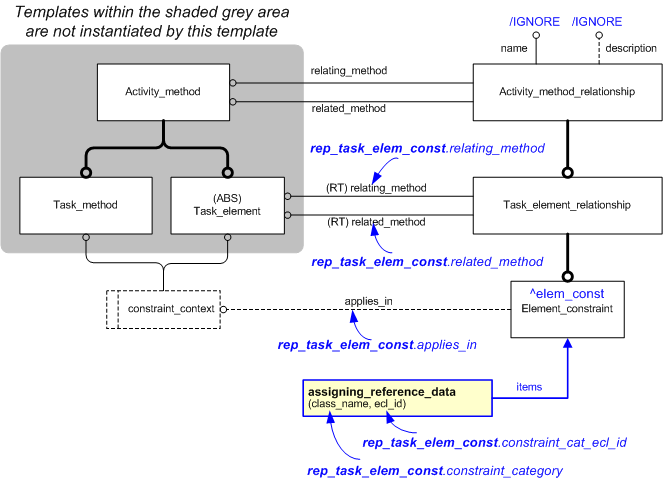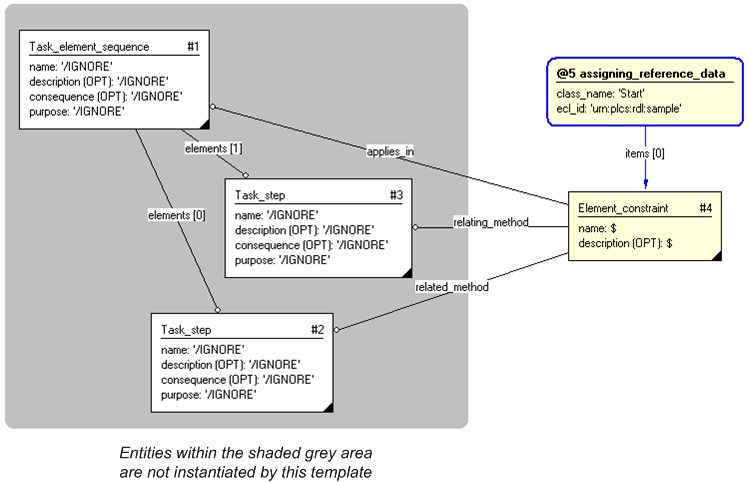Template:— representing_task_element_constraint (rep_task_elem_const)
Capability:representing_task |
Date: 2011/05/20 08:57:07
Revision: 1.4
|
This section specifies the template representing_task_element_constraint.
NOTE
The template has been defined in the context of the capability
representing_task
which provides an overall description of the
relevant parts of the ISO 10303-239 information model and a description
of related templates.
NOTE
An explanation of a template and the associated instantiation path is
provided in the
Template overview
section.
This template describes how to represent a constraint between two task elements within a certain context,
i.e. a time lag between element steps.
The EXPRESS-G diagram in
Figure
1
shows the templates and EXPRESS entities that are required
to represent the template
"representing_task_element_constraint".
The text highlighted in blue shows the template parameters.
Figure 1 — An EXPRESS-G representation of the Information model for representing_task_element_constraint
The graphic for the template to be used in other EXPRESS-G diagrams
is shown in Figure
2
below.
Figure 2 — The graphical representation of the representing_task_element_constraint template
The following input parameters are defined for this template:
The following classes and their sub-classes can be used:
The identifier of the
External_class_library
storing the definition of the class referenced by the parameter @constraint_category.
The following reference parameters are defined for this template:
Allow the
Element_constraint
entity instantiated in this path to be referenced when this template is used.
%^target = $representing_task_element_constraint.elem_const%
The following parameter combinations specify a uniqueness constraint:
Unique constraint: Element constraint
The instantiation path shown below specifies the entities that are to be
instantiated by the template.
A description of templates and the syntax for the instantiation path is
provided in the
Templates Help/Information section.
The following entities are instantiated with attributes as specified:
The instance diagram in Figure
3
shows an example of the EXPRESS entities and templates that are instantiated by the template:
/representing_task_element_constraint(relating_method='#3', related_method='#2', applies_in='#1', constraint_category='Start', constraint_cat_ecl_id='urn:plcs:rdl:sample')/
(an illustration of the consolidated representing_task_element_constraint template is shown in
Figure
4 below.)
Figure 3 — Entities instantiated by representing_task_element_constraint template
The instance model in STEP ASCII exchange file format (ISO 10303 Part
21 syntax) is:
#1 = TASK_ELEMENT_SEQUENCE('/IGNORE','/IGNORE','/IGNORE','/IGNORE',$,(#2,#3));
#2 = TASK_STEP('/IGNORE','/IGNORE','/IGNORE','/IGNORE',$);
#3 = TASK_STEP('/IGNORE','/IGNORE','/IGNORE','/IGNORE',$);
#4 = ELEMENT_CONSTRAINT($,$,#3,#2,#1);
#6 = CLASSIFICATION_ASSIGNMENT(#7,(#4),'/IGNORE');
#7 = EXTERNAL_CLASS('/NULL','Start','/IGNORE',#8);
#8 = EXTERNAL_CLASS_LIBRARY('urn:plcs:rdl:sample','/IGNORE');
The instance diagram in
Figure
4
shows the graphic symbol for the template that is to be
used in other instance diagrams. The example template is:
/representing_task_element_constraint(relating_method='#3', related_method='#2', applies_in='#1', constraint_category='Start', constraint_cat_ecl_id='urn:plcs:rdl:sample')/
Figure 4 — Instantiation of representing_task_element_constraint template
Characterizations
No common characterizations of the template
representing_task_element_constraint
have been identified. However, the ISO 10303-239 EXPRESS model
may enable other assignments to the entities instantiated by the template.




